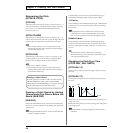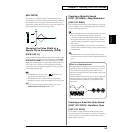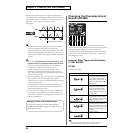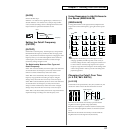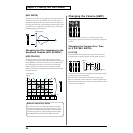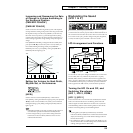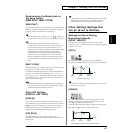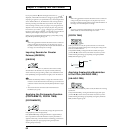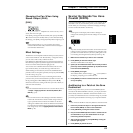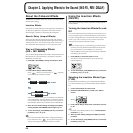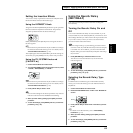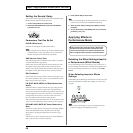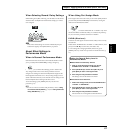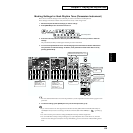
62
Chapter 2. Creating Your Own Sounds
If you press [VALUE ▲] while the Legato function is on, “ ” is
displayed, and the SH-32 switches to a retrigger-type legato. When
employing “Legato On” (as explained above), a smooth legato effect
can be obtained. However, the limitations of the sound generator’s
internal processing mean that there may be times when the pitch
does not change correctly when you jump to a key range that is not
adjacent to the current range (for example, the pitch may peak out).
In such cases, if you select “ ” (retrigger type), then while the
legato may lose a degree of fluidity, you can achieve a legato effect in
which the pitch changes correctly over a wider key range.
When you have finished making the settings, press [EXIT], causing
the [LEGATO] indicator light to go off.
When using glissando and other effects that create a continuous
change in the pitch while Legato is on, the pitch may not rise
beyond a certain fixed point, or there may be other limitations on
the range over which the pitch can change.
Layering Sounds for Greater
Fatness (UNISON)
[UNISON]
fig.02-47
When the Unison function is on, then the sound of the currently
selected Patch is divided into four separate sounds (oscillators),
which are then layered, providing a fatter, more substantial sound.
Press [UNISON], causing its indicator to light, to turn the effect on.
• Patches automatically switch to a single note when the Unison
function is used. When the Unison and Solo (p. 61) functions are
switched on at the same time, then the [SOLO] indicator to light
up.
• The Unison function cannot be used in Patches that use
Oscillator Sync (p. 55).
Applying the Portamento Function
(PORTAMENTO, PORTA TIME)
[PORTAMENTO]
fig.02-48
Portamento is an effect which smoothly changes the pitch from the
first-played key to the next-played key.
Press [PORTAMENTO], causing the indicator to light or blink, to
turn on portamento. When the indicator is lit, the portamento is
applied continuously; when the indicator is blinking, portamento is
applied only when you play legato (pressing one key before
releasing the previous key).
When using glissando and other effects that create a continuous
change in the pitch while Legato is on, the pitch may not rise
beyond a certain fixed point, or there may be other limitations on
the range over which the pitch can change.
Applying portamento while [SOLO] is on provides an effect
similar to the use of the slide technique on a violin.
[PORTA TIME]
fig.02-49
When portamento is used, this specifies the time over which the
pitch will change. Higher settings will cause the pitch change to the
next note to take more time.
Press [PORTA TIME], causing the indicator to blink, then press
[VALUE ▼/▲] to set the value (from 000 to 127). When you have
finished making the settings, press [EXIT], causing the [PORTA
TIME] indicator light to go off.
fig.02-50.e
Applying Analog-Like Modulation
to the Pitch (ANALOG FEEL)
[ANALOG FEEL]
fig.02-51
This creates a sort of instability in the sound, like that from an analog
synthesizer.
Press [ANALOG FEEL], causing the indicator to light, then press
[VALUE ▼/▲] to set the value (from 000 to 127). When you have
finished making the settings, press [EXIT], causing the [ANALOG
FEEL] indicator light to go off.
Portamento Time
Pitch



